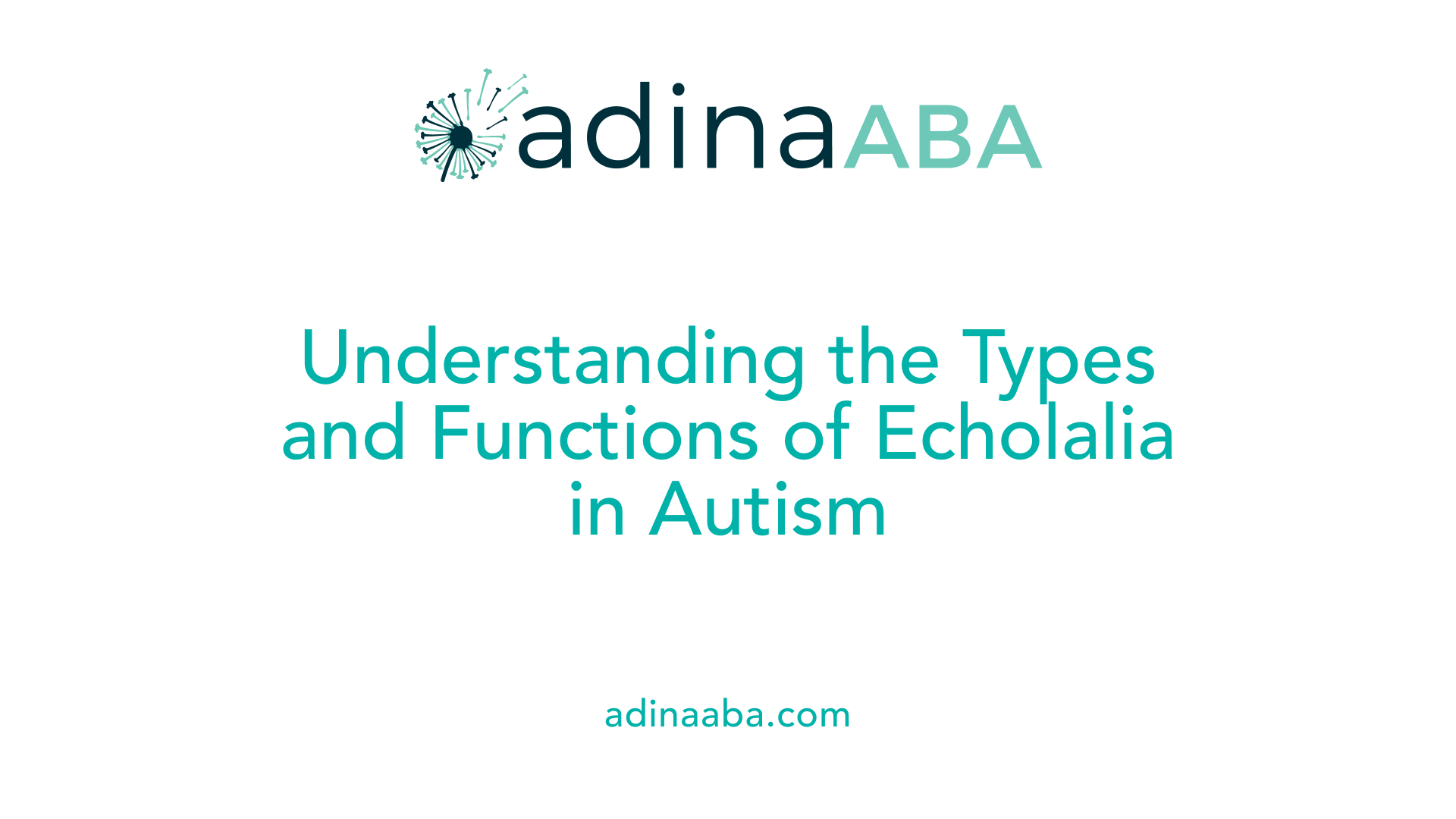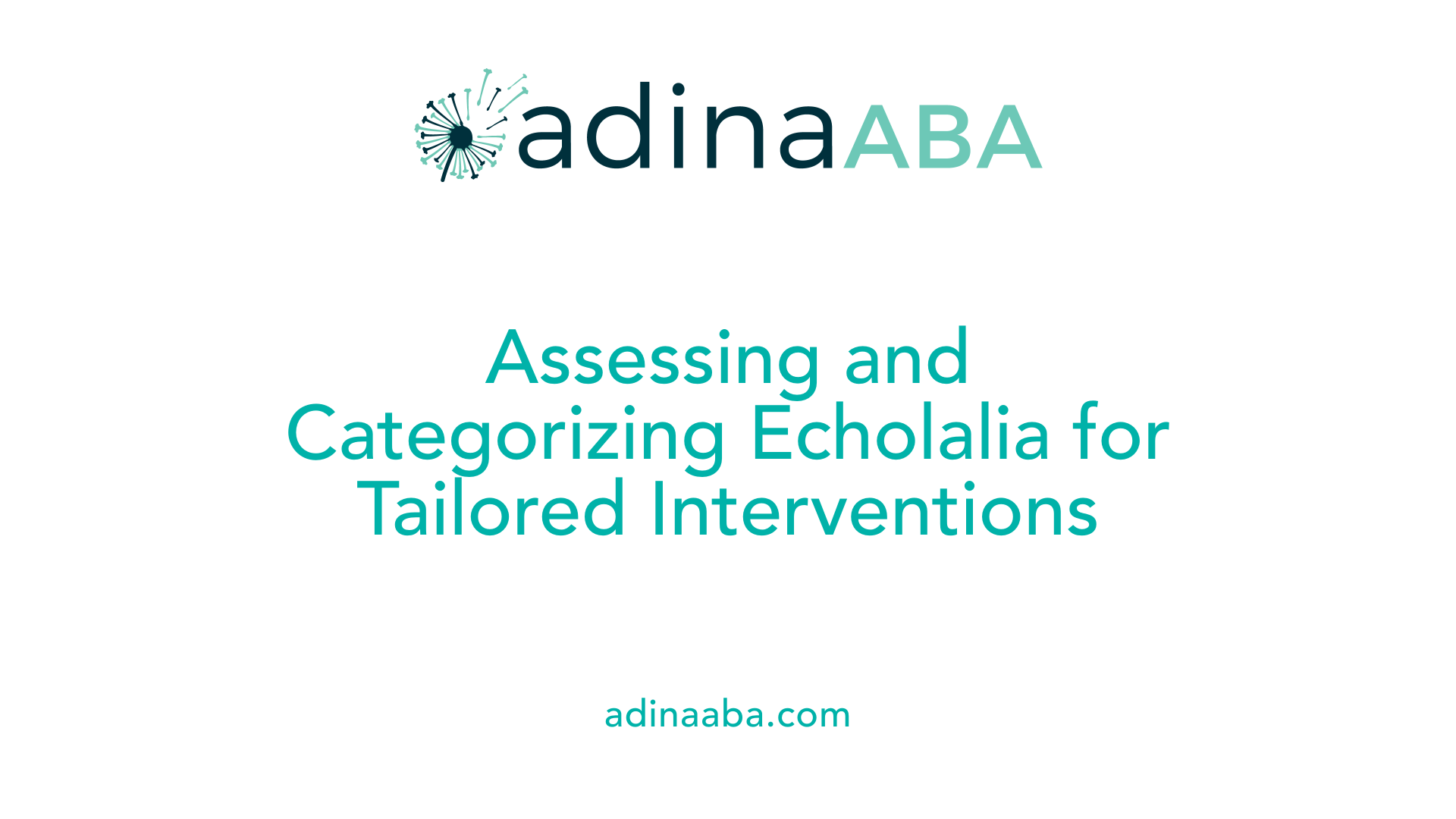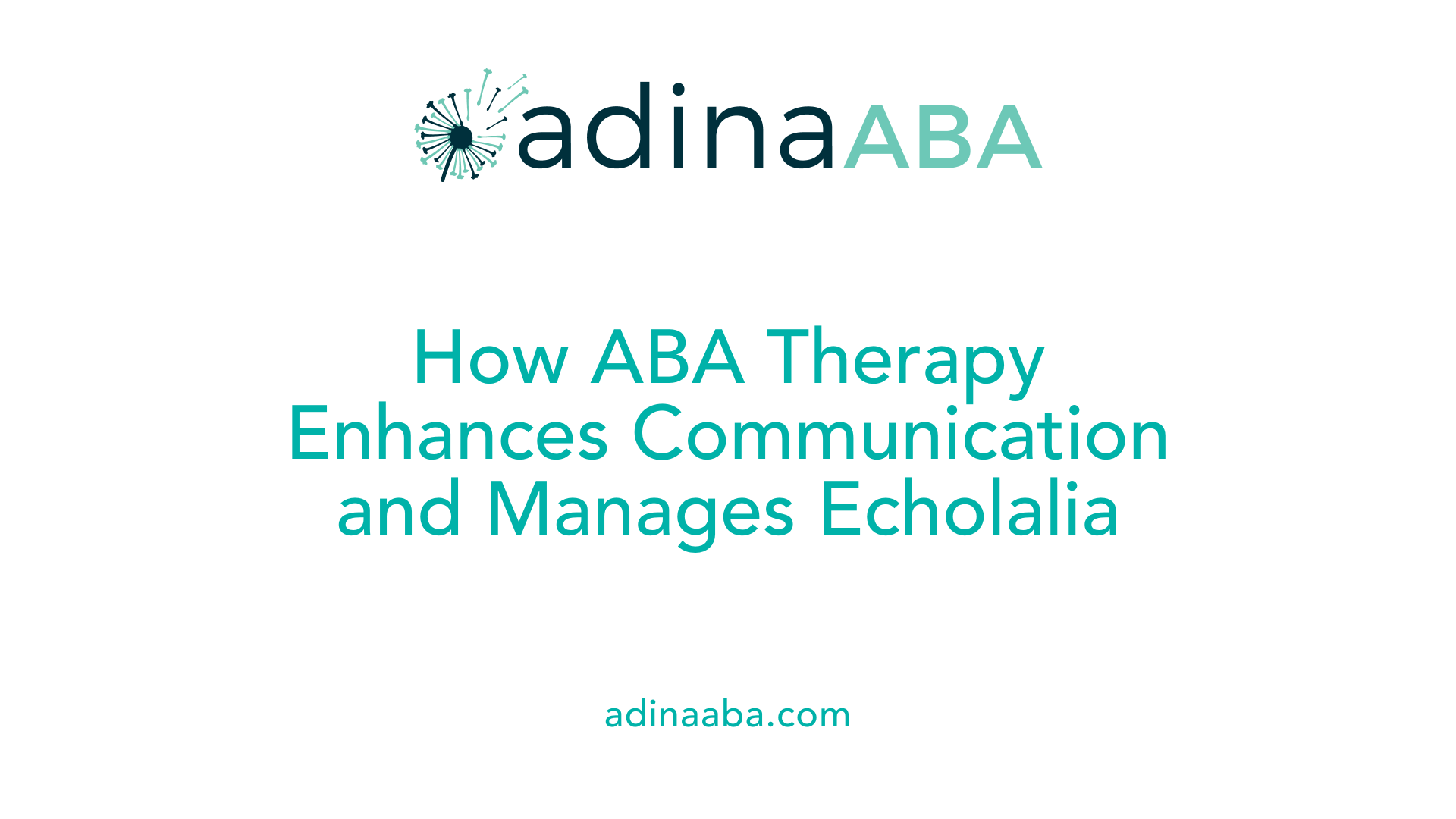How ABA helps address echolalia in autism

Understanding Echolalia and the Role of ABA in Autism
Echolalia, the repetitive vocalization common in children with autism, plays a significant role in their communication development. While it can serve various functions such as self-regulation or practicing speech, persistent echolalia often necessitates targeted intervention. Among the various therapeutic approaches, Applied Behavior Analysis (ABA) has emerged as a highly effective method to address echolalia, fostering functional communication and reducing maladaptive repetitions.
Comprehending Echolalia in Autism Spectrum Disorder

What are the different types of echolalia in autism?
Echolalia manifests in several forms among children with autism. The most common types are immediate and delayed echolalia. Immediate echolalia occurs right after an auditory stimulus, where a child repeats words or phrases immediately following hearing them. This type often helps children process language and participate in social exchanges.
Delayed echolalia, on the other hand, involves repeating phrases or sounds after a time gap, sometimes hours or days later. It may serve functions such as recalling information, providing comfort, or organizing thoughts. Other variations include interactive echolalia, where children use repetition to initiate or sustain communication, and non-interactive echolalia, which might occur as self-stimulatory behavior.
What functions does echolalia serve in children with autism?
In children with autism, echolalia often acts as a useful tool for understanding and navigating their environment. It can serve various purposes like self-regulation, where children repeat sounds or phrases to soothe themselves in stressful situations.
Echolalia also functions as a way to practice language, rehearse social interactions, or express needs when verbal skills are still developing. Additionally, this behavior can be a coping mechanism or an automatic response to sensory overload, helping children manage their emotions.
Furthermore, children often use echolalia to initiate conversations, draw attention, protest, or answer questions, thereby making it an important stepping stone toward more spontaneous language.
Why does echolalia persist beyond typical developmental stages?
While echolalia is common in toddlers up to age three as part of normal language development, it often persists in children with autism well beyond this age. The continuation can indicate challenges in transitioning to spontaneous speech and may highlight delays in expressive language.
Persistent echolalia may also reflect underlying difficulties in processing language and establishing functional communication skills. children might rely on repetition because it provides predictability, comfort, or a way to understand social cues.
Early assessment and tailored interventions, such as speech therapy and ABA strategies, are crucial in helping children move from echolalic speech to more natural, spontaneous language. By addressing the underlying causes and teaching alternative communication methods like visual supports or AAC devices, caregivers and professionals can support children in developing more effective ways of expressing themselves.
| Aspect | Details | Additional Notes |
|---|---|---|
| Types of echolalia | Immediate, Delayed, Interactive, Non-interactive | Differ in timing and purpose |
| Functions | Communication, Comfort, Self-regulation | Supports understanding and emotional control |
| Persistence reasons | Delayed speech development, Anxiety, Sensory issues | Indicates need for ongoing support |
Supporting children in managing echolalia involves a multidisciplinary approach, positive reinforcement, and customized strategies. Family involvement, professional guidance, and patience are vital to helping children achieve better communication skills, reduce repetitive behaviors, and improve social interactions.
Strategies to Manage Echolalia Effectively

What are effective strategies to help an autistic child manage echolalia?
Managing echolalia in children with autism involves a combination of targeted techniques and supportive environments. One practical approach is modeling clear and functional language. This means using simple, short phrases to demonstrate appropriate communication, and avoiding complex questions that could confuse or overwhelm the child.
Visual supports and schedules are powerful tools. They help children understand what to expect and provide cues that foster spontaneous language use. Visual aids can include picture cards, schedules, or visual timers, which support comprehension and encourage children to communicate more independently.
Speech therapy offers specific techniques tailored to each child's needs. Naturalistic interventions incorporate everyday routines and interests to teach communication in real-life contexts. Script training and verbal modeling help children learn and practice functional phrases, making communication more natural and effective.
Applied Behavior Analysis (ABA) employs reinforcement strategies to encourage desired behaviors. Using positive reinforcement, children are rewarded when they use appropriate language instead of echolalia. Techniques like prompting and fading gradually reduce prompts as children become more independent.
Patience and consistency are crucial. Repetition and structured practice allow children to process language gradually, reducing frustration and building confidence. Recognizing the purposes behind echolalia—whether self-stimulatory, comforting, or communicative—can also inform holistic strategies. In some cases, augmentative and alternative communication (AAC) devices may support children who find verbal speech challenging.
A comprehensive approach, combining these methods and tailored to individual needs, effectively helps children transition from echolalia to more spontaneous, functional communication, fostering greater independence and social engagement.
The Assessment and Categorization of Echolalia for Effective Intervention

What is echolalia in autism, and how can therapeutic interventions support communication development?
Echolalia is a common behavior among children with autism involving the repetition of words, sounds, or phrases heard previously. This behavior can be immediate, where the child repeats a phrase right after hearing it, or delayed, where the repetition occurs after some time has passed. Echolalia often serves multiple functions, such as helping children process language, self-soothe, express needs, or enjoy rhythmic patterns.
While echolalia is a natural phase in early language development, especially in toddlers, it can persist beyond age three in children with autism. When echolalia continues, it might indicate challenges in developing spontaneous, functional speech. Addressing this requires specialized interventions aimed at helping children shift from repetitive echoing to more deliberate and meaningful communication.
Therapeutic strategies like speech therapy and Applied Behavior Analysis (ABA) play crucial roles. These approaches include techniques such as scripting, naturalistic language teaching, and the use of augmentative and alternative communication (AAC) devices. They focus on encouraging children to produce their own words and sentences, reducing excessive echolalic speech, and fostering social interaction.
Supportive environments are vital, involving patience, consistent modeling, visual aids, and addressing sensory sensitivities. Family involvement and ongoing professional guidance are necessary to tailor interventions to each child's needs. The ultimate goal is to improve expressive language, facilitate social interaction, and decrease communication frustration, promoting better quality of life and integration.
How are different types of echolalia categorized?
Echolalia is categorized primarily based on timing and function. The main types include:
| Type | Description | Common Purpose / Notes |
|---|---|---|
| Immediate Echolalia | Repeating words or phrases instantly after hearing them | Often used for processing speech or social participation |
| Delayed Echolalia | Repeating phrases after a delay, sometimes hours or days later | Can serve as recall, comfort, or organizing thoughts |
| Functional Echolalia | Repetition used intentionally to communicate a need or desire | Useful in understanding a child's communication intent |
| Non-Functional | Repetitive speech without clear communicative purpose | May need targeted intervention to develop spontaneity |
Understanding these categories helps clinicians pinpoint the functions of echolalia and develop targeted intervention strategies.
How do professionals identify the functions of echolalia?
Identifying the purpose of echolalic speech involves detailed observation and assessment. Professionals look for clues about why a child repeats certain phrases:
- Is the repetition a way to self-soothe in stressful moments?
- Does it help in recalling information or structuring speech?
- Is it used to initiate interactions or draw attention?
- Might it serve to protest or express emotions?
Assessment involves language observation, parent reports, and sometimes formal testing to determine the context and purpose. Recognizing the function guides the choice of intervention techniques, such as prompting spontaneous speech, using visual supports, or reinforcing appropriate communication.
| Technique | Description | Purpose / When Used |
|---|---|---|
| Cues-Pause-Point | A method where a prompt is given, then pauses to allow response, and then points to reinforce | To encourage spontaneous responses |
| Script Training | Practice of specific phrases to develop functional language | Used to teach common social phrases |
| Visual Supports | Using pictures, symbols, or devices to aid communication | To clarify meaning and support language learning |
In conclusion, thorough assessment and understanding of echolalia’s type and function enable tailored interventions, fostering meaningful communication and reducing reliance on rote repetitions.
The Critical Role of ABA in Developing Functional Communication

How does ABA therapy address communication skills and manage echolalia in children with autism?
ABA therapy focuses on enhancing communication abilities in children with autism by implementing structured interventions that promote the development of functional, spontaneous speech. A central aspect of ABA is teaching children to use language purposefully, which includes replacing repetitive echolalic speech with meaningful communication.
One prominent method involves visual cues and modeling. For example, therapists might use picture schedules, visual supports, and straightforward verbal models to mimic appropriate responses, encouraging children to initiate or participate in exchanges naturally.
To better understand and manage echolalia, ABA differentiates between types of repetitions—distinguishing those that serve a purpose (like asking for something or initiating interaction) from non-functional repetitions. Techniques such as cues-pause-point training and script training assist in this effort, guiding children to produce more adaptable and contextually appropriate responses.
Reinforcement strategies play a vital role. Positive reinforcement, such as praise or preferred activities, encourages children to use functional language instead of rote echoing. Self-monitoring techniques help children recognize their responses, fostering independence and self-awareness in communication.
Furthermore, ABA emphasizes generalization—ensuring children carry these new skills across various settings and with different communication partners. This comprehensive approach supports meaningful language use and reduces reliance on echolalia as the primary communication method.
Teaching social and expressive skills
ABA programs incorporate social skills training, enabling children to understand social cues, share attention, and respond appropriately in conversational settings. This holistic focus enhances expressive language capabilities, making communication more spontaneous and contextually relevant.
Use of visual cues and modeling
Visual supports like PECS (Picture Exchange Communication System) and simple gestures assist children in expressing needs and desires. Verbal modeling, where therapists demonstrate the desired language patterns, helps children imitate and develop their expressive skills.
Differentiating functional from non-functional echolalia
Recognizing when echolalia serves a purpose—such as requesting or social greeting—allows therapists to reinforce these uses while gently discouraging repetitive, non-meaningful echoing. Targeted interventions guide children toward more flexible and spontaneous speech.
Reinforcement and self-monitoring techniques
Positive reinforcement motivates children by rewarding attempts at meaningful speech. Self-monitoring tools, like checklists or visual charts, foster awareness of their communication progress, encouraging ongoing effort.
Promoting generalization across settings
ABA emphasizes applying learned communication skills in everyday environments—home, school, and community—to ensure consistency and durability of improvements. This might involve collaborative efforts with caregivers and educators, using tailored strategies to embed these skills into daily routines.
| Strategy | Application | Benefits |
|---|---|---|
| Visual Supports | Picture schedules, PECS | Enhances understanding and expression |
| Verbal Modeling | Demonstrating speech | Encourages imitation and learning |
| Cues-Pause-Point | Structured response prompts | Clarifies expected responses |
| Reinforcement | Praise, preferred activities | Motivates target behaviors |
| Generalization | Practicing across settings | Ensures skills are used broadly |
| Self-Monitoring | Visual checklists | Builds independence |
Understanding and applying these techniques allows ABA to effectively address echolalia, transforming it from a barrier into a bridge for more meaningful communication.
Techniques and Strategies Used in ABA to Address Echolalia
What is echolalia in autism, and how can therapeutic interventions support communication development?
In children with autism, echolalia involves repeating words, phrases, or sounds heard in their environment, often serving as a way to process language, self-regulate, or communicate needs. It can occur immediately after hearing a phrase or after a delay, and may fulfill functions like self-stimulation, rehearsing speech, or easing anxiety.
While echolalia is a common transitional phase in early language development, persistent echolalia beyond age three may signal challenges with functional communication. Therapeutic interventions, such as speech therapy and applied behavior analysis (ABA), focus on supporting children to use their speech more meaningfully.
ABA therapy emphasizes understanding individual echolalia patterns and addressing their functions. It aims to reduce unnecessary repetition while promoting spontaneous, purposeful speech. Techniques like scripting, naturalistic models, visual supports, and the inclusion of assistive devices help children gain new ways of expressing themselves.
Supporting communication development involves patience, consistent modeling, and creating an environment that reduces sensory overload. Family involvement and ongoing professional guidance are vital to foster progress, helping children communicate more effectively and navigate social interactions with confidence.
Monitoring Progress and Generalization in ABA Therapy
How does ABA therapy address communication skills and manage echolalia in children with autism?
ABA therapy plays a vital role in improving communication in children with autism by focusing on developing functional speech and reducing repetitive behaviors like echolalia. The approach involves structured strategies such as social skills training, verbal modeling, and visual cues to support language learning.
To specifically manage echolalia, ABA employs techniques like cues-pause-point training, script training, and differential reinforcement. These methods help children learn to produce more appropriate, goal-directed language instead of relying solely on rote repetition. By reinforcing correct responses and encouraging spontaneous communication, ABA encourages children to express their needs and thoughts more effectively.
ABA also recognizes that echolalia may serve different purposes, such as self-regulation or communication, influenced by neurological or developmental factors. Therefore, therapists aim to decrease maladaptive repetitions while fostering the child's ability to develop meaningful language skills. Incorporating self-monitoring and positive reinforcement helps guide progress, gradually leading to improved verbal independence and functional speech. Overall, ABA's targeted interventions support children in transitioning from repetitive speech to purposeful language use, empowering them to participate more actively in social settings.
Building a Foundation for Effective Communication
In summary, ABA therapy plays a crucial role in helping children with autism manage echolalia by addressing its functions, teaching alternative communication methods, and reinforcing functional language use. Through comprehensive assessment, tailored strategies, and consistent reinforcement, ABA empowers children to develop meaningful and spontaneous communication skills. When integrated with family and educational support, ABA can significantly improve the quality of life for children with autism, laying the groundwork for successful social interactions and independence.
References
- How ABA Therapy Addresses Echolalia in Children | Unique Pathways
- Echolalia in Children with Autism, What It Is and How to Support ...
- Understanding Echolalia in Autism: Why It Happens and How to Help
- Echolalia - StatPearls - NCBI Bookshelf
- Understanding Echolalia in Children with Autism - Dr. Mary Barbera
- Echolalia and Autism - Golden Care Therapy
- Echolalia - StatPearls - NCBI Bookshelf
More Resources
Expert Clinicians
Get started today ->






